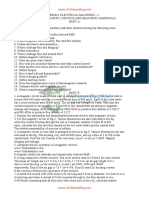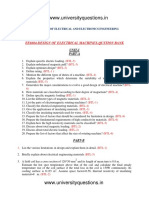Tutorial 2
Uploaded by
Mohamad SyazwanTutorial 2
Uploaded by
Mohamad SyazwanTutorial 2: Power Semiconductor Switches 1.
Describe three (3) types of power switches and give an example of semiconductor device fall under each category. 2. State three (3) effect of reverse recovery on diode 3. State the difference between current driven device and voltage driven device. Give an example of semiconductor devices for each type of devices. 4. The reverse recovery time of a diode is t rr 3s , and the rate of fall of the diode current is di / dt 30 A / s . Determine, a)the storage charge QRR , b)the peak reverse current I RR . 5. State 2 advantages and 2 disadvantage of MOSFET. 6. Forward conductor loss and switching loss are two types of losses that occur in real power switches but not in ideal power switch. Explain why these conditions happen. 7. The maximum junction temperature of a transistor is 150oC and the ambient temperate is 25oC. If the thermal resistance from junction to case is 0.4oC/W, thermal resistance from case to sink is 0.1oC/W and thermal resistance from sink to ambient is 0.5oC/W, Determine: a) Maximum power dissipation b) Case temperature c) Sink temperature 8. A MOSFET absorbs a thermal power of 17+10-3fs W, where fs is the switching frequency. The thermal resistances are 50C/W from the junction to the case, 90C/W for the case to the heat sink, and 2.50C/W for the heat sink to ambient. Assume ambient temperature is 400C and maximum junction temperature is 1750C. Determine the largest switching frequency that can be operated without a heat sink. 9. A MOSFET with no heat sink absorbs a thermal power of 2.0W. The thermal resistance from junction to ambient is 400C/W, if the ambient temperature is 300C. Determine the junction temperature and if the maximum junction temperature is 1500C, how much power can be absorbed without requiring a heat sink.
You might also like
- 1: Choose The Best Answer of The Following (20 Marks) : P P S S100% (1)1: Choose The Best Answer of The Following (20 Marks) : P P S S4 pages
- Is Electric Current A Scalar or Vector QuantityNo ratings yetIs Electric Current A Scalar or Vector Quantity3 pages
- Learning Information Sheet F.1.3 TR Tech 5No ratings yetLearning Information Sheet F.1.3 TR Tech 517 pages
- Electrical Machines Assignment 1 3rd Sem 2024-25No ratings yetElectrical Machines Assignment 1 3rd Sem 2024-257 pages
- Is Electric Current A Scalar or Vector Quantity100% (1)Is Electric Current A Scalar or Vector Quantity3 pages
- PHYS 211 13ELECTRICITYCIRCUITand - OHMS LAWNo ratings yetPHYS 211 13ELECTRICITYCIRCUITand - OHMS LAW5 pages
- EE02-Electrical-Transient-Analysis_April-2025No ratings yetEE02-Electrical-Transient-Analysis_April-20254 pages
- ASSIGNMENT ELE 7208 Advanced High Voltage Enginering: Chapter Per StudentNo ratings yetASSIGNMENT ELE 7208 Advanced High Voltage Enginering: Chapter Per Student3 pages
- Chapter 3: Transformer: Electrical MachineNo ratings yetChapter 3: Transformer: Electrical Machine39 pages
- Proposed 15 Numerical Problems For PresentationNo ratings yetProposed 15 Numerical Problems For Presentation8 pages
- Ee 6604 Design of Electrical Machines Question BankNo ratings yetEe 6604 Design of Electrical Machines Question Bank12 pages
- Hiccup Mode Current Limiting: L F Application NoteNo ratings yetHiccup Mode Current Limiting: L F Application Note5 pages
- Experiment 5 Lab Report Uitm Malaysian College0% (1)Experiment 5 Lab Report Uitm Malaysian College16 pages
- Zener Diode Power Supply Basics Electrics Devices and Circtuits CompE350No ratings yetZener Diode Power Supply Basics Electrics Devices and Circtuits CompE3505 pages
- Chapter 04 - Motion and Force - DynamicsNo ratings yetChapter 04 - Motion and Force - Dynamics24 pages











































































